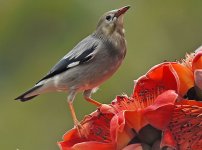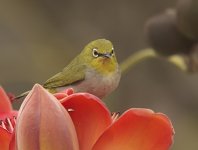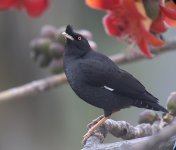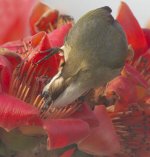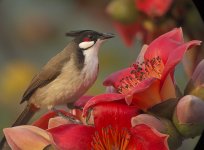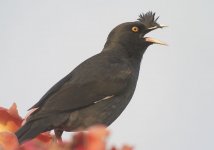Digiscoping with a Panasonic G1 and Pentax spotting scopes
I have in the past been frustrated in finding a digiscope setup for my otherwise superb Pentax scopes. The problem has been in part the lack of a solid adapter like those for Swarovski, Leica, Zeiss, etc. The Panasonic G1 seems to be a large part of the solution for me.
My experiments involved Pentax PF -80ED-A and PF-65ED-A scopes with both the 20-60mm Pentax SMC eyepiece (8-24mm) and the Pentax SMC XW14 wide-angle eyepiece.
1) The G1 using the 14-45 kit lens works well with the SMC XW14 eyepiece. From the 18-50mm range, there is no vignetting. Zoom more than that, and vignetting becomes a problem. You need to remove any filters you may have on the G1. When I first tried it, I had a UV filter on the G1. This caused the camera to be too far from the eyepiece and caused major vignetting problems. When I removed the filter, the G1 lens can rest right up against the rubber guard on the eyepiece, and vignetting problems are eliminated for about 1/2 the zoom range.
2) The G1 does NOT work well with 20-60X eyepiece. The vignetting is terrible at all focal lengths.
3) The G1 works with the SMC XW14 eyepiece because the latter has a huge diameter, approximately the same size as the G1 lens. The G1 would probably NOT work on scopes with much smaller diameter eyepieces, e.g. Nikon Fieldscopes.
4) The choice between the two models of Pentax scopes is a matter of personal preference. The 80ED lets in more light, but also significantly increases the magnification making "camera shake" much more of a problem to deal with. The 65ED lets in slightly less light, but has so much to commend it in lower price, much smaller size, and less motion to stabilize. NOTE that the 65ED comes standard with smaller diameter and lower quality XF eyepieces, which I am confident will NOT work with the G1. The XW series of eyepieces are options and are the ones you want.
5) Attaching the G1 to the telescope. The quality of any digiscoped photos is a direct function of (a) how closely aligned and square you can get the camera to the scope eyepiece, and (b) how well you are able to eliminate camera movement. Swarovski, Zeiss, and Leica have great adaptors to quickly mount and unmount a digiscoping camera to the scope. Pentax only recently released a swing-arm adapter that seems too flimsy for a camera as heavy as the G1. For testing, I simply hand-held the camera to the eyepiece. This worked far better than expected, because the rubber eyepiece rim fits nicely up against the black border around the G1 lens. A fear I usually have that the eyepiece will scratch the camera lens is dealt with beautifully -- it is nearly impossible if you are careful. I even left the lens hood on. Because I was pressing the lens up against the eyepiece rubber guard, it was easy to establish the correct distance from the scope and square the camera to the scope.
MOTION - hand-holding the camera against the eyepiece imposes undesirable motion on the whole setup, and remember in digiscoping all motion is vastly magnified compared to what the camera's IS can deal with. In an ideal world, the camera would be held there by a hands-free adapter and the shutter triggered by a remote release to minimize motion, but my world is less than ideal. (Note: in answer to a previous comment, the G1 does have a remote shutter release jack and the wired release is about $25.) My "solution" was to set the shutter on rapid fire and shoot off a burst of photos. Any motion caused by my pressing the shutter would have ended before the 2d or 3rd shot. You shoot a LOT of shots, but I find one has to do that always in digiscoping since the keeper percentage is always going to be low.
I left the camera on autofocus. I would focus on the subject in the scope with the scope focusing, then hold the G1 up to the lens and let AF work. I found it nearly impossible to use manual focus in this setup.
Here are a few samples.
a cormorant at 250+ yards (near the far shore in the center on the rock-like object): at 28mm and
digiscoped with Pentax PF-80ED-A scope :
Some Willets at 28mm and
one of those Willets digiscoped with the Pentax PF-65-A scope:
Finally, a Spotted Sandpiper that seemed to want its picture taken:
The digiscoped photos were taken in RAW at full 12MP resolution. I then cropped them down so I was only using 40-50% of the photo (the willet as cropped was 2514x1885, the sandpiper 2167x1525). Remember that you are not going to get the same resolution from this setup as your normal shot, so you want to minimize cropping and try to fill the frame as much as possible at the time you take the shot.
The digiscoped shots needed a lot of post-processing. Out of the camera, they seemed low contrast and somewhat soft. The Pentax scopes are very sharp and high contrast; it may just be that the light is passing through a lot of layers of glass by the time it reaches the sensor.
I did my PP in Lightroom 2.3. I adjusted the black point, increased the "clarity" substantially, and cranked the sharpening up as much as it would go. The results were very encouraging IMO -- much better contrast and minimal artifacts. I then downsized the photos to 800x600 pixels for posting to the web.
I look forward to any suggestions and experiences others have.
I have in the past been frustrated in finding a digiscope setup for my otherwise superb Pentax scopes. The problem has been in part the lack of a solid adapter like those for Swarovski, Leica, Zeiss, etc. The Panasonic G1 seems to be a large part of the solution for me.
My experiments involved Pentax PF -80ED-A and PF-65ED-A scopes with both the 20-60mm Pentax SMC eyepiece (8-24mm) and the Pentax SMC XW14 wide-angle eyepiece.
1) The G1 using the 14-45 kit lens works well with the SMC XW14 eyepiece. From the 18-50mm range, there is no vignetting. Zoom more than that, and vignetting becomes a problem. You need to remove any filters you may have on the G1. When I first tried it, I had a UV filter on the G1. This caused the camera to be too far from the eyepiece and caused major vignetting problems. When I removed the filter, the G1 lens can rest right up against the rubber guard on the eyepiece, and vignetting problems are eliminated for about 1/2 the zoom range.
2) The G1 does NOT work well with 20-60X eyepiece. The vignetting is terrible at all focal lengths.
3) The G1 works with the SMC XW14 eyepiece because the latter has a huge diameter, approximately the same size as the G1 lens. The G1 would probably NOT work on scopes with much smaller diameter eyepieces, e.g. Nikon Fieldscopes.
4) The choice between the two models of Pentax scopes is a matter of personal preference. The 80ED lets in more light, but also significantly increases the magnification making "camera shake" much more of a problem to deal with. The 65ED lets in slightly less light, but has so much to commend it in lower price, much smaller size, and less motion to stabilize. NOTE that the 65ED comes standard with smaller diameter and lower quality XF eyepieces, which I am confident will NOT work with the G1. The XW series of eyepieces are options and are the ones you want.
5) Attaching the G1 to the telescope. The quality of any digiscoped photos is a direct function of (a) how closely aligned and square you can get the camera to the scope eyepiece, and (b) how well you are able to eliminate camera movement. Swarovski, Zeiss, and Leica have great adaptors to quickly mount and unmount a digiscoping camera to the scope. Pentax only recently released a swing-arm adapter that seems too flimsy for a camera as heavy as the G1. For testing, I simply hand-held the camera to the eyepiece. This worked far better than expected, because the rubber eyepiece rim fits nicely up against the black border around the G1 lens. A fear I usually have that the eyepiece will scratch the camera lens is dealt with beautifully -- it is nearly impossible if you are careful. I even left the lens hood on. Because I was pressing the lens up against the eyepiece rubber guard, it was easy to establish the correct distance from the scope and square the camera to the scope.
MOTION - hand-holding the camera against the eyepiece imposes undesirable motion on the whole setup, and remember in digiscoping all motion is vastly magnified compared to what the camera's IS can deal with. In an ideal world, the camera would be held there by a hands-free adapter and the shutter triggered by a remote release to minimize motion, but my world is less than ideal. (Note: in answer to a previous comment, the G1 does have a remote shutter release jack and the wired release is about $25.) My "solution" was to set the shutter on rapid fire and shoot off a burst of photos. Any motion caused by my pressing the shutter would have ended before the 2d or 3rd shot. You shoot a LOT of shots, but I find one has to do that always in digiscoping since the keeper percentage is always going to be low.
I left the camera on autofocus. I would focus on the subject in the scope with the scope focusing, then hold the G1 up to the lens and let AF work. I found it nearly impossible to use manual focus in this setup.
Here are a few samples.
a cormorant at 250+ yards (near the far shore in the center on the rock-like object): at 28mm and
digiscoped with Pentax PF-80ED-A scope :
Some Willets at 28mm and
one of those Willets digiscoped with the Pentax PF-65-A scope:
Finally, a Spotted Sandpiper that seemed to want its picture taken:
The digiscoped photos were taken in RAW at full 12MP resolution. I then cropped them down so I was only using 40-50% of the photo (the willet as cropped was 2514x1885, the sandpiper 2167x1525). Remember that you are not going to get the same resolution from this setup as your normal shot, so you want to minimize cropping and try to fill the frame as much as possible at the time you take the shot.
The digiscoped shots needed a lot of post-processing. Out of the camera, they seemed low contrast and somewhat soft. The Pentax scopes are very sharp and high contrast; it may just be that the light is passing through a lot of layers of glass by the time it reaches the sensor.
I did my PP in Lightroom 2.3. I adjusted the black point, increased the "clarity" substantially, and cranked the sharpening up as much as it would go. The results were very encouraging IMO -- much better contrast and minimal artifacts. I then downsized the photos to 800x600 pixels for posting to the web.
I look forward to any suggestions and experiences others have.




